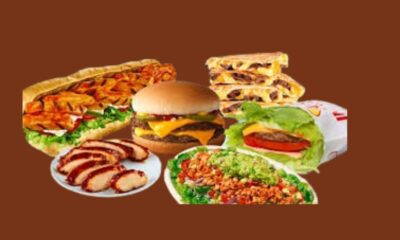food
Best Takeout Food: Enjoy Delicious Meals in the Comfort of Your Home

In today’s fast-paced world, finding time to cook a homemade meal can be challenging. Luckily, the rise of takeout food has provided a convenient solution for those craving delicious meals without the hassle of cooking. From savory Chinese dishes to indulgent pizzas, there’s a plethora of options to choose from when it comes to takeout food. In this article, we’ll explore the best takeout food options, tips for ordering, and how to keep your takeout meals fresh and tasty.
Introduction to Takeout Food
What is takeout food?
Takeout food, also known as takeaway or to-go food, refers to meals prepared by restaurants or food establishments that are intended to be consumed off-premises. These meals are typically packaged in containers suitable for transport and can be enjoyed at home, at work, or even on-the-go.
Popularity of takeout food.
Takeout food has surged in popularity in recent years due to its convenience and accessibility. With busy schedules and hectic lifestyles, many individuals find it challenging to cook meals from scratch every day. Takeout food offers a convenient alternative, allowing people to enjoy restaurant-quality meals without the need for extensive preparation or cleanup.
Convenience factor.
One of the primary appeals of takeout food is its convenience. With just a few taps on a smartphone or a quick phone call, you can have a delicious meal delivered straight to your doorstep. This convenience factor makes takeout food an attractive option for busy professionals, families, and anyone looking for a hassle-free dining experience.
Factors to Consider When Choosing Takeout Food
When it comes to selecting the perfect takeout meal, there are several factors to consider to ensure a satisfying dining experience.
Taste and quality.
The taste and quality of the food should be top priority when choosing takeout. Look for restaurants known for their flavorful and well-prepared dishes to ensure a delicious meal.
Variety of options.
A diverse menu with plenty of options allows you to cater to different preferences and dietary restrictions. Choose restaurants that offer a wide variety of cuisines and dishes to satisfy everyone’s cravings.
Price affordability.
While takeout food can be convenient, it’s essential to consider the cost. Look for restaurants that offer affordable options without compromising on taste or quality.
Healthiness and dietary restrictions.
For those with dietary restrictions or health-conscious individuals, it’s crucial to choose takeout options that align with your dietary needs. Many restaurants offer healthy choices, including vegetarian, vegan, gluten-free, and low-calorie options.
Top 10 Best Takeout Food Options
When it comes to takeout food, the possibilities are endless. Here are ten of the best takeout food options that are sure to satisfy your cravings:
- Chinese cuisine: From savory stir-fries to crispy spring rolls, Chinese takeout offers a wide range of flavorful dishes.
- Pizza: A classic favorite, pizza is perfect for sharing with family and friends or enjoying solo.
- Sushi: Fresh and delicious, sushi is a popular choice for takeout, offering a variety of flavors and textures.
- Indian curry dishes: Rich and aromatic, Indian curry dishes are perfect for warming up on a chilly evening.
- Mexican tacos and burritos: Spicy and satisfying, Mexican takeout is sure to please your taste buds.
- Mediterranean falafel and shawarma: Packed with flavor, Mediterranean takeout offers a healthy and delicious option.
- Thai stir-fries and curries: Bursting with bold flavors, Thai takeout is a favorite among food lovers.
- American burgers and fries: Indulgent and comforting, American takeout is perfect for a satisfying meal.
- Italian pasta and lasagna: Hearty and satisfying, Italian takeout is a classic choice for any occasion.
- Japanese ramen: Noodle lovers rejoice – Japanese ramen is the ultimate comfort food for any day of the week.
Regional Takeout Favorites
In addition to these global favorites, each region has its own takeout specialties that reflect the local cuisine and culture. Here are some regional takeout favorites worth trying:
- New York City: Authentic New York-style pizza and bagels.
- New Orleans: Flavorful Cajun and Creole dishes like gumbo and jambalaya.
- California: Fresh and healthy options like sushi bowls and avocado toast.
- Texas: Mouthwatering BBQ brisket and Tex-Mex tacos.
Tips for Ordering Takeout Food
To ensure a seamless and enjoyable takeout experience, consider the following tips:
Utilizing food delivery apps.
Popular food delivery apps like Uber Eats, DoorDash, and Grubhub make ordering takeout a breeze, offering a wide selection of restaurants and cuisines to choose from.
Reading reviews and ratings.
Before placing an order, take a moment to read reviews and ratings from other customers to gauge the quality and consistency of the restaurant.
Customizing orders.
Many restaurants allow you to customize your order to suit your preferences, whether it’s adjusting spice levels, swapping ingredients, or adding extra toppings.
Being mindful of delivery times.
To ensure your food’arrives hot and fresh, be mindful of delivery times and choose a delivery window that works for you.
How to Keep Takeout Food Fresh and Delicious
While takeout food’is convenient, it’s essential to take proper precautions to keep it fresh and delicious.
Proper packaging.
Choose restaurants that use high-quality packaging to ensure your food’stays fresh during transit. Opt for containers that are leak-proof and microwave-safe for easy reheating.
Reheating techniques.
If your takeout meal requires reheating, use proper techniques to maintain its flavor and texture. Avoid overheating to prevent dryness or sogginess.
Storage tips.
If you’re not planning to eat your takeout meal immediately, store it in the refrigerator promptly to prevent spoilage. Proper storage will help preserve the quality of the food for later enjoyment.
Benefits of Takeout Food
Takeout food offers several benefits that make it an appealing option for busy individuals and families:
- Time-saving: With takeout, you can enjoy a delicious meal without the time and effort required for cooking and cleanup.
- Convenience for busy individuals: Takeout food is perfect for those with busy schedules who don’t have time to cook or dine out.
- Enjoyment in the comfort of home: Whether you’re watching a movie with family or enjoying a cozy night in, takeout food’allows you to relax and indulge without leaving the comfort of home.
Drawbacks of Takeout Food
While takeout food’is convenient, it’s essential to be mindful of its potential drawbacks:
- Health concerns: Takeout food’is often high in calories, sodium, and unhealthy fats, which can contribute to weight gain and other health issues.
- Environmental impact: The packaging used for takeout food, such as plastic containers and utensils, can contribute to environmental pollution if not disposed of properly.
- Lack of freshness: Takeout food may not always be as fresh or flavorful as a homemade meal, especially if it’s been sitting for a while or has undergone reheating.
Innovations in the Takeout Food Industry
As technology continues to evolve, so too does the takeout food industry. Here are some innovative trends shaping the future of takeout food:
- Virtual kitchens: Also known as ghost kitchens or cloud kitchens, virtual kitchens are dedicated spaces for preparing takeout orders without the need for a traditional dining area.
- Contactless delivery options: In response to the COVID-19 pandemic, many restaurants have implemented contactless delivery options to minimize contact between customers and delivery drivers.
- Sustainable packaging initiatives: To reduce their environmental footprint, many restaurants are exploring sustainable packaging alternatives, such as compostable containers and reusable bags.
Conclusion
Takeout food’offers a convenient and delicious dining option for individuals and families alike. Whether you’re craving Chinese stir-fry, Italian pasta, or Mexican tacos, there’s a takeout option to satisfy every palate. By following these tips for ordering and storage, you can enjoy your favorite takeout meals fresh and flavorful every time.
Unique FAQs
Is takeout food safe to eat during the COVID-19 pandemic?
Takeout food’is generally considered safe to eat during the COVID-19 pandemic, as long as proper precautions are taken, such as washing hands before eating and handling food’safely.
How can I make my takeout food healthier?
To make your takeout food’healthier, opt for dishes that are grilled or steamed rather than fried, choose lean protein options, and load up on vegetables.
Can I reheat takeout food in the microwave?
Yes, most takeout food can be reheated in the microwave. Just be sure to use microwave-safe containers and heat the food evenly to avoid cold spots.
Are there any eco-friendly alternatives to traditional takeout packaging?
Yes, many restaurants now offer eco-friendly alternatives to traditional takeout packaging, such as compostable containers made from plant-based materials.
How can I support local restaurants while ordering takeout?
You can support local restaurants by ordering directly from their websites or calling in your order rather than using third-party delivery apps, as this helps them avoid hefty commission fees.
food
What to Eat: A Comprehensive Guide to a Balanced Diet Introduction

Ever wondered what to eat to stay healthy and fit? You’re not alone. Eating the right foods is crucial for maintaining good health and well-being. This guide will dive into the essentials of a balanced diet, covering everything from macronutrients and micronutrients to special diets and tips for healthy eating. Let’s explore how you can make better food choices every day.
Understanding Nutrition
What is Nutrition?
Nutrition is the process of providing or obtaining the food necessary for health and growth. It’s about giving your body the right nutrients in the right amounts to function properly.
Macronutrients vs. Micronutrients
- Macronutrients: These are nutrients required in larger amounts that provide the energy necessary to maintain body functions and carry out daily activities. They include carbohydrates, proteins, and fats.
- Micronutrients: These are essential vitamins and minerals needed in smaller amounts that play crucial roles in bodily processes such as bone health, immune function, and wound healing.
Macronutrients Explained
Carbohydrates
Carbohydrates are the body’s primary energy source.
- Types of carbohydrates: Simple (sugars) and complex (starches and fibers).
- Healthy sources of carbohydrates: Whole grains, fruits, vegetables, and legumes.
Proteins
Proteins are essential for building and repairing tissues, and they also serve as a secondary energy source.
- Importance of proteins: They are vital for muscle development, immune function, and hormone production.
- Best sources of proteins: Lean meats, fish, dairy products, beans, nuts, and seeds.
Fats
Fats are necessary for hormone production, protecting organs, and absorbing vitamins.
- Good fats vs. bad fats: Good fats (unsaturated fats) are beneficial, while bad fats (saturated and trans fats) can harm health.
- Sources of healthy fats: Avocados, nuts, seeds, olive oil, and fatty fish.
Micronutrients and Their Importance
Vitamins
Vitamins are organic compounds that are crucial for various metabolic processes.
- Essential vitamins and their sources:
- Vitamin A: Carrots, sweet potatoes
- Vitamin C: Citrus fruits, bell peppers
- Vitamin D: Sun exposure, fortified dairy products
- Vitamin E: Nuts, seeds
Minerals
Minerals are inorganic elements that support body functions.
- Key minerals and where to find them:
- Calcium: Dairy products, leafy greens
- Iron: Red meat, beans, spinach
- Magnesium: Nuts, whole grains
Hydration: The Unsung Hero
Importance of Water
Water is essential for every cell, tissue, and organ in your body. It aids in digestion, absorption, circulation, and temperature regulation.
How Much Water Should You Drink?
A general guideline is to drink eight 8-ounce glasses of water a day, but individual needs can vary based on activity level, climate, and overall health.
Building a Balanced Plate
The Concept of a Balanced Meal
A balanced meal includes a mix of macronutrients and micronutrients to ensure your body gets the necessary nutrients. Aim for half your plate to be fruits and vegetables, a quarter protein, and a quarter whole grains.
Portion Control
Being mindful of portion sizes helps prevent overeating and ensures you get a variety of nutrients without excessive calorie intake.
Healthy Eating Tips
Meal Prepping
Preparing meals in advance can save time and help you stick to healthy eating habits. Plan your meals for the week and batch cook to make healthy choices more convenient.
Reading Food Labels
Understanding food labels can help you make informed choices. Look for items low in added sugars, saturated fats, and sodium.
Smart Grocery Shopping
Shop the perimeter of the store where fresh produce, dairy, and meats are located. Avoid processed foods found in the aisles and always make a shopping list to stay on track.
Special Diets and Their Benefits
Vegetarian and Vegan Diets
These diets focus on plant-based foods and exclude meat (vegetarian) or all animal products (vegan). They can lower the risk of heart disease and improve overall health.
Mediterranean Diet
This diet emphasizes fruits, vegetables, whole grains, nuts, and olive oil, with moderate fish and poultry intake. It’s known for promoting heart health.
Keto Diet
A high-fat, low-carbohydrate diet that aims to put the body into a state of ketosis, where it burns fat for energy. It can be effective for weight loss but may not be suitable for everyone.
Paleo Diet
This diet focuses on eating foods that would have been available to our hunter-gatherer ancestors, like lean meats, fish, fruits, vegetables, nuts, and seeds, and avoids processed foods, grains, and dairy.
Foods to Avoid
Processed Foods
Processed foods often contain unhealthy levels of added sugars, sodium, and fats. They lack essential nutrients and can contribute to health problems.
Sugary Drinks
Drinks high in sugar, like sodas and some juices, provide empty calories and can lead to weight gain and other health issues.
Trans Fats
Trans fats are found in many fried and baked goods. They increase bad cholesterol levels and lower good cholesterol levels, raising the risk of heart disease.
The Role of Fiber in Your Diet
Benefits of Fiber
Fiber aids in digestion, helps maintain a healthy weight, and lowers the risk of diabetes and heart disease.
High-Fiber Foods
Foods high in fiber include fruits, vegetables, whole grains, and legumes. Aim to include a variety of these in your diet.
Eating for Different Life Stages
Children
Children need a diet rich in nutrients to support their growth and development. Include plenty of fruits, vegetables, whole grains, and lean proteins.
Teenagers
Teens have higher nutritional needs due to growth spurts. Ensure they get enough calcium, iron, and protein from diverse sources.
Adults
Adults should focus on maintaining a balanced diet to support energy levels, muscle maintenance, and overall health.
Seniors
Older adults need fewer calories but more nutrients like calcium, vitamin D, and fiber to support bone health and digestion.
Eating for Specific Health Conditions
Heart Health
Focus on foods that support heart health, like leafy greens, berries, nuts, and fatty fish. Limit saturated fats and sodium.
Diabetes
Managing diabetes involves eating balanced meals that include fiber-rich foods, lean proteins, and healthy fats while avoiding refined sugars and carbs.
Weight Management
For weight management, balance your calorie intake with physical activity. Prioritize nutrient-dense foods and avoid high-calorie, low-nutrient options.
The Psychological Aspect of Eating
Mindful Eating
Mindful eating involves paying attention to what you eat and how you eat. It helps you enjoy your food more and recognize hunger and fullness cues.
Emotional Eating
Emotional eating is using food to cope with emotions. Identifying triggers and finding healthier coping mechanisms can help break this habit.
Common Myths About Healthy Eating
Debunking Popular Myths
- Myth: Carbs are bad for you. Fact: Carbs are essential; choose complex carbs over simple ones.
- Myth: All fats are bad. Fact: Healthy fats are crucial for your body.
Evidence-Based Facts
Scientific research supports balanced diets rich in whole foods, emphasizing the importance of variety and moderation.
Conclusion
Eating a balanced diet is essential for maintaining good health and preventing chronic diseases. By understanding nutrition, making informed food choices, and adopting healthy eating habits, you can significantly improve your well-being. Remember, it’s not just about what you eat but how you eat. Stay mindful, stay healthy, and enjoy your food!
FAQs
How can I start eating healthier?
Start by incorporating more whole foods like fruits, vegetables, lean proteins, and whole grains into your diet. Gradually reduce your intake of processed foods and sugary drinks.
What are some quick and healthy snack ideas?
Some healthy snack ideas include apple slices with peanut butter, Greek yogurt with berries, a handful of nuts, or carrot sticks with hummus.
Is it necessary to take supplements?
It’s best to get your nutrients from food. However, if you have specific deficiencies or dietary restrictions, supplements may be necessary. Consult with a healthcare provider.
How can I manage cravings for unhealthy foods?
Stay hydrated, eat regular balanced meals, and include healthy snacks. Sometimes cravings can be a sign of nutrient deficiencies or emotional needs.
What are the benefits of eating seasonal produce?
Seasonal produce is often fresher, more flavorful, and more nutritious. It’s also better for the environment and can be more cost-effective.
food
Best Fast Food Protein: A Guide to Making Healthier Choices

Fast food has become a staple in modern society, offering convenience and affordability to busy individuals. While often criticized for its lack of nutritional value, there are options available that can provide a significant source of protein, an essential macronutrient for muscle repair, satiety, and overall health. In this article, we’ll explore the best fast food protein choices, their nutritional value, health considerations, and tips for making healthier choices.
Fast food protein refers to the protein sources commonly found in popular fast food chains. These include burger patties, grilled chicken, fish sandwiches, and veggie burgers. While these options may not always be the healthiest choices, they can still contribute to meeting daily protein requirements, especially for individuals with busy lifestyles.
Popular Fast Food Protein Options
Burger Patties
Burger patties, typically made from beef, are a ubiquitous fast food protein option. While they are often high in protein, they can also be high in saturated fat and calories, depending on the type of meat and preparation method.
Grilled Chicken
Grilled chicken sandwiches or strips are a leaner alternative to beef patties, offering a good source of protein with less fat and fewer calories. However, it’s essential to be mindful of added sauces or breading that can increase the calorie and sodium content.
Fish Sandwiches
Fish sandwiches, such as those made with cod or pollock, can provide a healthy dose of protein and omega-3 fatty acids. Opting for grilled rather than fried options can further enhance their nutritional value.
Veggie Burgers
Veggie burgers, made from plant-based ingredients like beans, lentils, or vegetables, are a popular choice for vegetarians and those looking to reduce their meat consumption. While they may not always have as much protein as meat-based options, they can still be a nutritious choice when prepared with wholesome ingredients.
Nutritional Value of Fast Food Protein
When comparing the nutritional value of fast food protein options, it’s essential to consider not only the protein content but also the fat and calorie content. While some options may be high in protein, they can also be high in unhealthy fats and calories, which can contribute to weight gain and other health issues.
Health Considerations
Sodium Levels
Many fast food items, including protein options like burger patties and chicken sandwiches, are high in sodium, which can contribute to high blood pressure and other cardiovascular problems. Opting for grilled or baked options and asking for sauces on the side can help reduce sodium intake.
Additives and Preservatives
Fast food protein options often contain additives and preservatives to enhance flavor and prolong shelf life. While these ingredients are generally recognized as safe, consuming them in excess may have long-term health implications. Choosing minimally processed options whenever possible can help mitigate this risk.
Impact on Cholesterol Levels
Some fast food protein options, particularly those high in saturated and trans fats, can negatively impact cholesterol levels, increasing the risk of heart disease. Choosing leaner protein options and limiting consumption of fried and processed foods can help maintain healthy cholesterol levels.
Balancing Fast Food Protein with Other Nutrients
While fast food protein can be a convenient option for busy individuals, it’s essential to balance it with other nutrients for a well-rounded meal.
Incorporating Vegetables
Adding vegetables to fast food meals can increase their nutritional value by providing essential vitamins, minerals, and fiber. Opting for salads or adding extra vegetables to sandwiches can help boost their nutrient content.
Choosing Whole Grain Options
Choosing whole grain bread or bun options can provide additional fiber and nutrients compared to refined grain options. Whole grains can also help promote feelings of fullness and satiety, reducing the likelihood of overeating.
Limiting Sugary Beverages
Pairing fast food protein options with water or unsweetened beverages instead of sugary sodas or shakes can help reduce overall calorie and sugar intake. Water is also essential for staying hydrated, especially when consuming salty or processed foods.
Alternative Fast Food Protein Sources
In recent years, there has been a growing demand for alternative fast food protein sources to accommodate diverse dietary preferences and ethical considerations.
Plant-Based Options
Fast food chains are increasingly offering plant-based protein options, such as tofu, tempeh, and plant-based burgers, to cater to vegetarian and vegan customers. These options can provide a comparable amount of protein to traditional meat-based options while offering additional health benefits.
Customization and Substitutions
Many fast food restaurants allow customers to customize their orders by substituting protein options or modifying toppings and sauces. This flexibility enables individuals to create meals that align with their dietary preferences and nutritional goals.
Tips for Making Healthier Choices
Making healthier choices when dining at fast food restaurants involves being mindful of portion sizes, ingredients, and preparation methods.
Reading Nutrition Labels
Checking nutrition labels or accessing nutritional information online can help individuals make informed choices about their food options. Paying attention to serving sizes and nutrient content can guide decisions toward healthier options.
Portion Control
Fast food portions are often oversized, leading to excessive calorie intake. Choosing smaller portion sizes or sharing meals with others can help control portion sizes and prevent overeating.
Avoiding Fried Items
Fried fast food items, such as chicken nuggets and French fries, are typically high in unhealthy fats and calories. Opting for grilled or baked options can significantly reduce calorie and fat intake.
The Role of Fast Food in a Balanced Diet
While fast food should not be the primary source of nutrition, it can still be enjoyed in moderation as part of a balanced diet.
Occasional Indulgence vs. Regular Consumption
Enjoying fast food occasionally as a treat or indulgence is unlikely to have a significant impact on overall health. However, regularly consuming fast food as a primary source of nutrition can lead to nutrient deficiencies and health problems over time.
Incorporating Physical Activity
Balancing fast food consumption with regular physical activity can help mitigate its negative effects on health. Engaging in activities like walking, jogging, or cycling can burn excess calories and improve overall fitness levels.
Addressing Common Myths and Misconceptions
Despite its reputation, fast food protein options can be part of a healthy diet when consumed in moderation and alongside other nutritious foods.
Protein Quality in Fast Food vs. Home-Cooked Meals
While homemade meals are often perceived as healthier than fast food options, the quality of protein can be similar between the two. Choosing lean protein options and balancing them with vegetables and whole grains can make fast food meals nutritious and satisfying.
Perceived Health Risks
While fast food consumption has been associated with various health risks, such as obesity and heart disease, it is not inherently unhealthy. Making informed choices, practicing moderation, and incorporating physical activity can help mitigate these risks and maintain overall health.
Impact of Fast Food Protein on Weight Management
Fast food protein can play a role in weight management when consumed as part of a balanced diet and combined with regular physical activity.
Satiety and Portion Control
Protein-rich foods have been shown to promote feelings of fullness and satiety, which can help prevent overeating and support weight management goals. Pairing fast food protein options with fiber-rich foods like vegetables and whole grains can further enhance feelings of fullness.
Building Muscle vs. Promoting Weight Gain
For individuals looking to build muscle, fast food protein options can provide a convenient source of protein to support muscle repair and growth. However, it’s essential to balance protein intake with overall calorie intake to avoid weight gain.
The Evolution of Fast Food Protein Options
As consumer preferences and dietary trends evolve, fast food chains are continually innovating their menu offerings to cater to changing demands.
Trends in Consumer Preferences
Consumer preferences for healthier, more sustainable food options have influenced the development of new fast food protein options, such as plant-based burgers and alternative protein sources.
Innovation in Menu Offerings
Fast food chains are increasingly incorporating innovative ingredients and preparation methods to appeal to health-conscious consumers. From plant-based proteins to gluten-free options, there is a growing variety of choices available to accommodate diverse dietary preferences.
Sustainability and Ethical Considerations
In addition to nutritional considerations, sustainability and ethical concerns play a significant role in shaping consumer attitudes toward fast food protein options.
Sourcing Practices
Consumers are becoming more conscious of the environmental and ethical implications of their food choices, leading to increased demand for sustainably sourced and ethically produced ingredients.
Environmental Impact
The production of animal-based protein can have a significant environmental impact, including greenhouse gas emissions and deforestation. Choosing plant-based protein options or opting for sustainably sourced meat can help reduce the environmental footprint of fast food consumption.
Cultural and Regional Variations
Fast food preferences vary widely across different cultures and regions, leading to diverse menu offerings and culinary traditions.
Global Fast Food Trends
While traditional fast food chains like McDonald’s and Burger King dominate the global market, regional fast food chains and street food vendors offer unique and culturally diverse protein options.
Regional Specialties
From sushi burgers in Japan to currywurst in Germany, fast food protein options vary widely depending on the cultural and regional preferences of consumers. These regional specialties offer a glimpse into the diverse culinary landscape of fast food around the world.
Addressing Dietary Restrictions
Fast food chains are increasingly catering to individuals with dietary restrictions by offering specialized menu items and alternative ingredients.
Gluten-Free Options
For individuals with gluten sensitivities or celiac disease, many fast food chains offer gluten-free options, such as salads, grilled meats, and gluten-free buns.
Dairy-Free Alternatives
Individuals with lactose intolerance or dairy allergies can find dairy-free alternatives at many fast food restaurants, including plant-based milkshakes and dairy-free desserts.
Conclusion
While fast food often gets a bad rap for its perceived lack of nutritional value, there are options available that can provide a significant source of protein and other essential nutrients. By making informed choices, practicing moderation, and balancing fast food protein with other nutrient-rich foods, individuals can enjoy the convenience of fast food without compromising their health.
Unique FAQs
Is fast food protein unhealthy?
While some fast food options may be high in unhealthy fats and calories, there are protein choices available that can be part of a balanced diet when consumed in moderation.
How can I make healthier choices at fast food restaurants?
Opt for grilled or baked protein options, choose salads or vegetable sides, and limit high-calorie extras like cheese and mayonnaise.
Are plant-based protein options healthier than meat-based options?
Plant-based protein options can be healthier in terms of their impact on the environment and may offer additional health benefits, such as lower saturated fat content and higher fiber content.
Can I still enjoy fast food while trying to lose weight?
Yes, you can enjoy fast food occasionally as part of a balanced diet when combined with regular physical activity and portion control.
Are there any sustainable fast food protein options?
Some fast food chains offer sustainably sourced and ethically produced protein options, such as grass-fed beef or organic tofu
-

 Health10 months ago
Health10 months agoBrain Health: Nourishing Your Mind for Optimal Functioning
-

 food9 months ago
food9 months agoBest Fast Food Protein: A Guide to Making Healthier Choices
-

 Health10 months ago
Health10 months agoBlisterata: Understanding and Managing the Condition
-

 Health9 months ago
Health9 months agoThe Ultimate Guide to the 30 30 Workout
-

 management10 months ago
management10 months agoIntroduction to Project Valvrein
-

 food9 months ago
food9 months agoWhat to Eat: A Comprehensive Guide to a Balanced Diet Introduction
